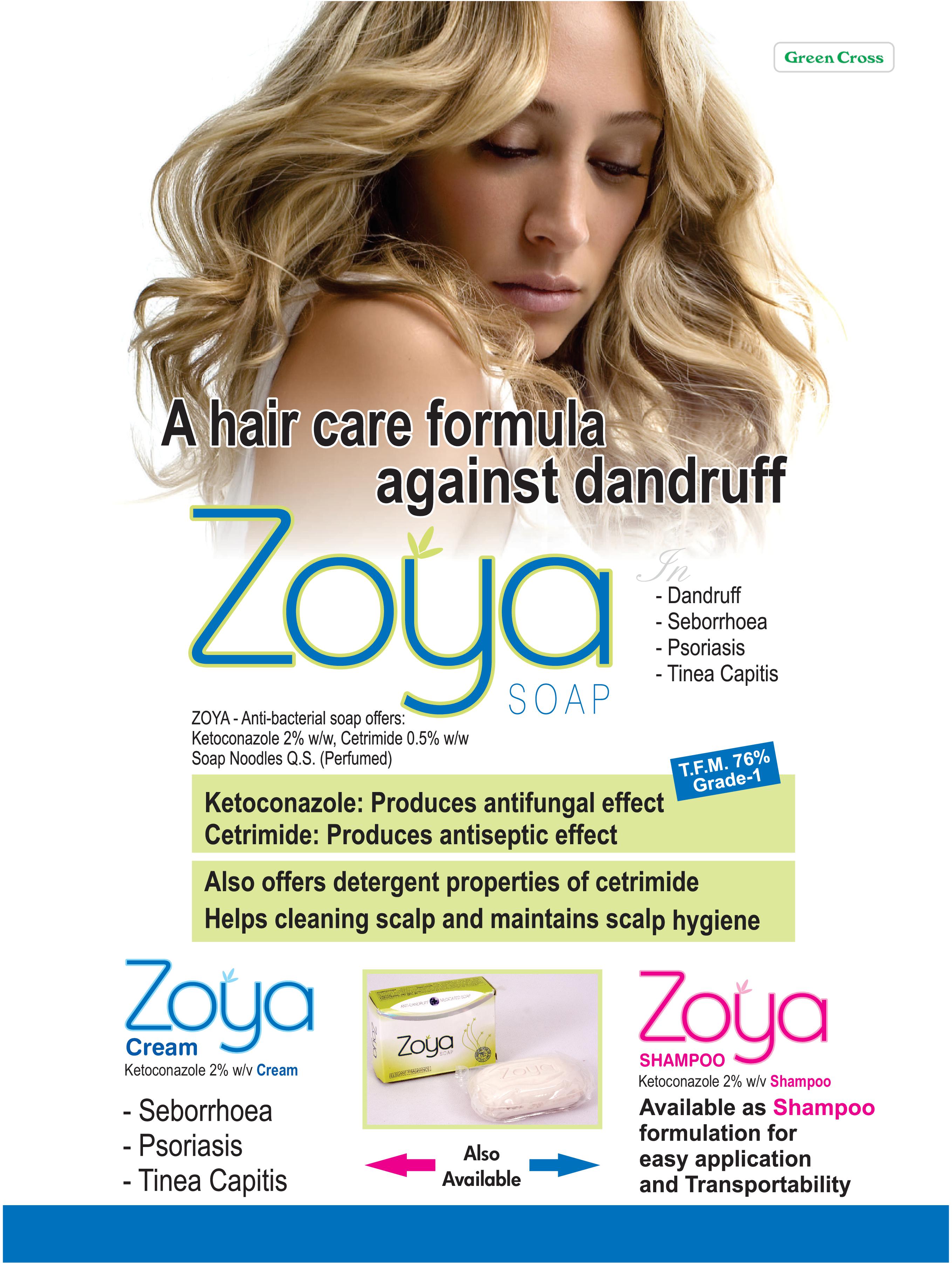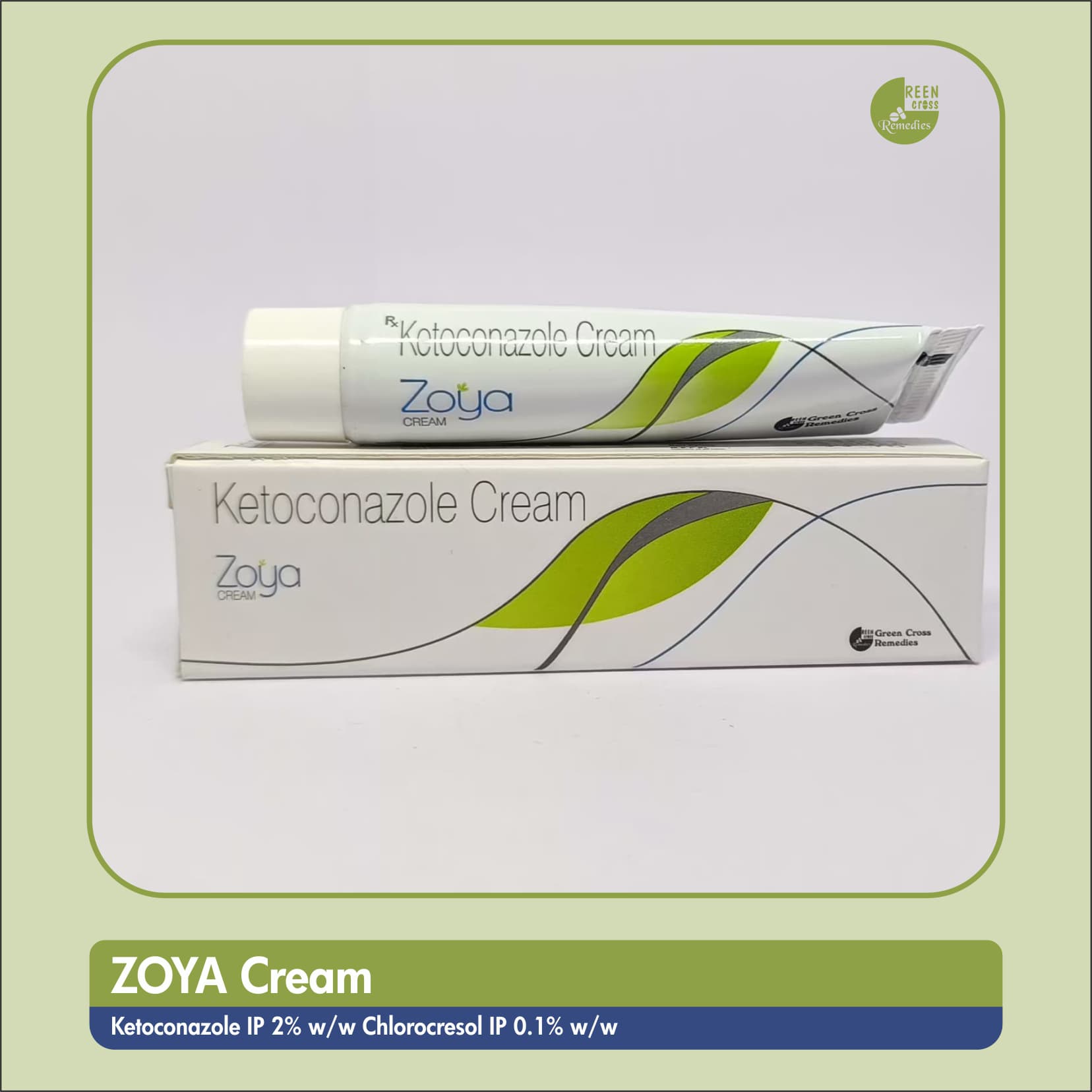ZOYA Cream

Ketoconazole IP 2 % w/w, Chlorocresol IP 0.1 % w/w Cream Use, Indication, Side Effects, Dosage, Mechanism of Action, Price, Contra-Indications, Drug Interactions...
ZOYA Cream (Ketoconazole 2% w/w and Chlorocresol 0.1% w/w)
Uses and Indications :
ZOYA Cream is a topical medication primarily used to treat various fungal infections of the skin. It contains Ketoconazole, which is an antifungal agent, and Chlorocresol, a preservative with antimicrobial properties. The main uses of ZOYA Cream include:
-
Fungal Skin Infections: It is used to treat superficial fungal infections such as athlete's foot, ringworm, jock itch, and tinea versicolor.
-
Dermatophyte Infections: Used for conditions caused by dermatophytes, which are fungi that affect the skin, hair, and nails.
-
Seborrheic Dermatitis: Can be used to treat seborrheic dermatitis, a skin condition characterized by red, flaky, and greasy skin, often on the face, scalp, or chest.
-
Pityriasis Versicolor: A fungal infection that causes discolored patches on the skin.
Mechanism of Action :
-
Ketoconazole: Ketoconazole is a azole antifungal. It works by inhibiting the synthesis of ergosterol, a key component of the fungal cell membrane. Without ergosterol, the fungal cell membrane becomes compromised, leading to the death of the fungus. Ketoconazole is effective against a wide range of fungal pathogens, including dermatophytes and yeasts.
-
Chlorocresol: Chlorocresol is an antimicrobial preservative that helps prevent the growth of bacteria and fungi in the cream itself, ensuring the product remains stable and effective. It also has mild antimicrobial effects when applied topically to the skin.
Together, these ingredients help treat fungal infections while preventing contamination in the product.
Dosage and Application :
ZOYA Cream should be used as directed by a healthcare provider. The typical recommended dosage is:
-
Clean and dry the affected area before applying the cream.
-
Apply a thin layer of ZOYA Cream to the affected skin area, usually once or twice a day, depending on the severity of the infection.
-
Continue use for the recommended duration, even if symptoms improve, to ensure that the infection is completely treated. Treatment duration may range from 2 to 4 weeks, depending on the infection.
Important: Do not apply the cream to open wounds or mucous membranes (e.g., eyes, mouth, nose). If irritation or excessive redness occurs, discontinue use and consult a doctor.
Side Effects :
Common side effects of ZOYA Cream are usually mild and localized. These may include:
-
Skin irritation (redness, itching, burning, or stinging at the application site)
-
Dryness or peeling of the skin
-
Rash or allergic reactions at the application site
-
Contact dermatitis (skin inflammation)
-
Sensitivity to sunlight (photosensitivity)
Rare but serious side effects may include:
-
Severe allergic reactions (e.g., swelling, difficulty breathing, or hives)
-
Severe skin reactions (e.g., blistering, peeling, or open sores)
If any severe side effects occur, you should seek medical attention immediately.
Contraindications :
ZOYA Cream should not be used in the following cases:
-
Hypersensitivity or Allergy: If you are allergic to Ketoconazole, Chlorocresol, or any other ingredients in the cream.
-
Open Wounds or Mucous Membranes: Avoid applying the cream to broken skin, mucous membranes (e.g., eyes, mouth, nose), or large open areas of the skin.
-
Pregnancy and Breastfeeding: While topical Ketoconazole is generally considered safe in pregnancy and breastfeeding, it's always advisable to consult a doctor before use.
Drug Interactions :
ZOYA Cream is applied topically and has minimal systemic absorption, so it is less likely to interact with other medications. However, there are a few things to be aware of:
-
Topical Products: Avoid using other topical products on the same area unless directed by a healthcare provider. Some other products might interact with Ketoconazole or cause further irritation.
-
Other Antifungal Medications: While systemic antifungal medications like oral Ketoconazole are used for more extensive infections, combining them with ZOYA Cream should be done cautiously, and only under the guidance of a healthcare professional.
Since the systemic absorption of Ketoconazole from topical use is minimal, significant drug interactions are rare. However, always inform your doctor of any other medications you're using.
For Use of registered medical practitioner or a hospital only

